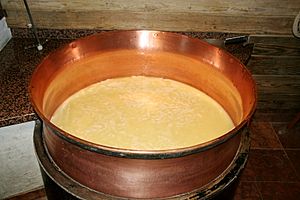Fermentation facts for kids

Fermentation is a natural process where tiny living things, like yeast or certain bacteria, turn sugar into other substances. They do this to get energy, often without using oxygen. It's like a mini-factory working inside a cell!
This process also describes how we grow microorganisms to get a specific chemical product. A famous French scientist named Louis Pasteur studied fermentation and discovered how tiny microbes cause it. The scientific study of fermentation is called zymology.
Yeast is a common organism that ferments. When yeast ferments sugar, it uses the sugar and produces alcohol and carbon dioxide. This process involves a special helper molecule called NAD. In living things, NAD helps move tiny electrons from one chemical reaction to another. Fermentation is a way for cells to get energy, but it's not as efficient as using oxygen (which is called oxidative respiration).
The alcohol made by yeast is used to create beverages or even biofuel. Yeast is also used to help bakery products like bread and cakes rise faster. Sometimes, yeast can even speed up the process of making wine.
Other types of cells can ferment sugar to make vinegar or lactic acid. Interestingly, the fermentation process can even continue and turn the alcohol into vinegar, which is also known as acetic acid.
How Fermentation Works
When yeast ferments, it breaks down a type of sugar called glucose (C6H12O6). This breakdown creates ethanol (CH3CH2OH), which is a type of alcohol, and carbon dioxide (CO2) gas.
Types of Fermentation
There are different kinds of fermentation, depending on what is produced:
- Ethanol fermentation always makes ethanol and carbon dioxide. This type is very important in making bread, brewing beer, and making wine.
- Lactic acid fermentation produces lactic acid. This happens in the muscles of animals, including humans, when they need a lot of energy very quickly. For example, if you exercise really hard, the pain you feel in a cramped muscle can be caused by the build-up of lactic acid. The pain goes away as your blood carries the lactic acid away.
Images for kids
-
Fermentation in progress: Bubbles of CO2 form a froth on top of the fermentation mixture.
See also
 In Spanish: Fermentación para niños
In Spanish: Fermentación para niños




